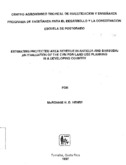| dc.contributor.author | Henry, M.H.D. | |
| dc.date.accessioned | 2014-10-17T15:01:35Z | |
| dc.date.available | 2014-10-17T15:01:35Z | |
| dc.date.issued | 1997 | es_ES |
| dc.identifier | 354311 | es_ES |
| dc.identifier.uri | https://repositorio.catie.ac.cr/handle/11554/1709 | |
| dc.identifier.uri | http://orton.catie.ac.cr/repdoc/A0474i/A0474i.pdf | es_ES |
| dc.description | Tesis (M. Sc) -- CATIE, Turrialba (Costa Rica),1997 | es_ES |
| dc.description.abstract | A contingent valuation method (CVM) survey was administered to two groups of foreign visitors and two groups of local residents, representing both actual and potential visitors to the proposed Wallings Forest National Park in Antigua, during the period April to August, 1997. The primary objectives were to determine the willingress to play (WTP) for entrance fees to the proposed park, and to evaluate the CVM as a useful valuation technique for protected area planning in the context of Antigua and Barbuda and other developing countries of the Caribbean. Secondary objectives included evaluating the possible existence of information bias by examining the differences in WTP values of foreign visitors who had visited the proposed park and those who not, and the possible existence of cultural/strategic bias among local residents based on whether the respondents are interviewed in person or allowed to complete the questionnaires in private. The mean WTP for entrance to the proposed park was US29 and 22, for the group of foreign visitors who had not visited and those who visited, respectively. The mean WTP for the group of local residents who were interviewed in person was US7, compared to US6 for the group of local residents who completed the questionnaires in private. In addition, there was evidence that the amount of information provided was a significant factor in determining WTP. The presence of cultural/strategic bias, with respect to WTP among local respondents, based on whether the survey was conducted in person or whether residents responded privately, was also detected. Finally, the results indicate that the CVM is indeed a useful valuation technique that can be used in protected area planning in Antigua and Barbuda. | es_ES |
| dc.language.iso | en | es_ES |
| dc.publisher | CATIE, Turrialba (Costa Rica) | es_ES |
| dc.subject | BARBUDA | |
| dc.subject | AREAS SILVESTRES PROTEGIDAS | |
| dc.subject | RESERVAS NATURALES | |
| dc.subject | PARQUES NACIONALES | |
| dc.subject | VALORACION CONTINGENTE | |
| dc.subject | METODOS | |
| dc.subject | PLANIFICACION | |
| dc.subject | UTILIZACION DE LA TIERRA ANTIGUA | |
| dc.title | Estimating protected area revenue in Antigua and Barbuda: an evaluation of the CVM for land use planning in a developing country | es_ES |
| dc.type | Tesis de maestría | es_ES |
| dc.identifier.publication | Turrialba (Costa Rica) | es_ES |


